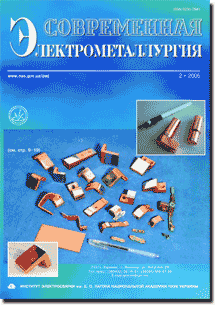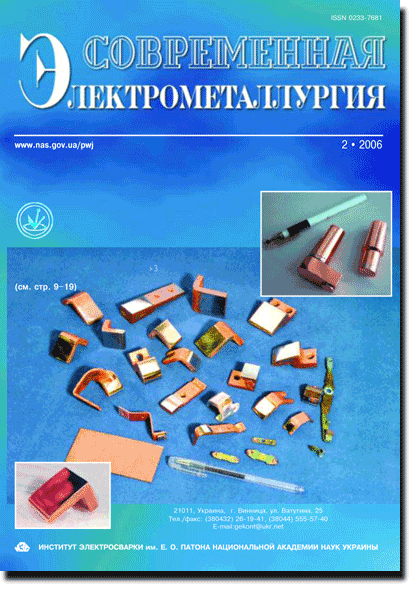| 2006 №01 | 2006 №03 |

CONTENTS

Towards the 90 birthday anniversary of Prof. B.I. Medovar
Paton B.E., Medovar L.B., Saenko V.Ya., Tsykulenko A.K., Fedorovsky B.B., Us V.I. and Shevchenko N.T. On welding, metals science and metallurgy in the scientist heritage or on present status and future of special electrometallurgy 2
ELECTROSLAG TECHNOLOGY
Eryomin E.N. and Zherebtsov S.N. Centrifugal electroslag casting of tractor bushings of turning hinge 5
Technology and equipment of a bay for centrifugal casting of thin-wall bushings of the K-700 tractor turning hinge are described. Results of the cast metal tests and advantages of the metal are shown.
ELECTRON BEAM PROCESSES
Grechanyuk N.I., Osokin V.A., Grechanyuk I.N., Kucherenko P.P., Minakova R.V., Golovkova M.E. and Kopylova G.E. Composite materials on base of copper and molybdenum, condensed from vapor phase, for electric contacts. Structure, properties, technology. Part 2. Fundamentals of electron beam technology for producing materials for electric contacts 8
Design peculiarities of the installation for performing high-rate electron beam evaporation-condensation are presented. Peculiarities of copper-base phase composition and structure of solidified pool (melt) are studied. Assumption is made about interrelation between structural-phase condition of the melt and rate of evaporation-condensation. Peculiarities of surface structure and condensate volume in various sections (before and after etching) are investigated. Technological defects and their influence on strength and ductility of the condensate during tensile test are considered. Interrelation between temperature dependence of strain activation energy, peculiarities of condensate failure, and technological defects of its structure of different origin are studied.
PLASMA-ARC TECHNOLOGY
Zhadkevich M.L., Shapovalov V.A., Melnik G.A., Zhirov D.M., Zhdanovsky A.A., Tsykulenko K.A. and Prikhodko M.S. Plasma liquid-phase reduction of iron from its oxides using gaseous reducers 18
It was established that rate and completeness of the process of liquid-phase reduction of iron from its oxides using gaseous reducers are mostly influenced by temperature in the reaction space, flow and composition of the reducer, and slag basicity. Equipment and methodology for investigation of the process, in which plasma heating is used for ensuring necessary temperature and activation of the reducer, are described. Influence of the gaseous reducer flow and composition on efficiency of its use, rate, and completeness of the reduction reaction proceeding, effect of the slag basicity on completeness of iron reduction and content of sulfur and phosphorus in it in case of using plasma heat sources are determined.
GENERAL PROBLEMS OF METALLURGY
Borisova A.L., Borisov Yu.S., Adeeva L.I., Tunik A.Yu., Karpets M.V. and Doroshenko L.K. Effect of alloying on composition, structure and properties of powders of alloy AlCuFe, containing quasi-crystalline phase 22
Results of investigation of effect of scandium and chromium on structure, phase composition and technological properties of powders of alloy AlCuFe, designed for producing thermal coatings, containing quasi-crystalline phase, are presented. Behavior of powders in heating was studied using method of differential thermal analysis, which allows predicting phase transformation processes that proceed under conditions of thermal spraying of coatings.
Firstov S.A., Zamkov V.N. , Brodnikovsky N.P., Topolsky V.F., Kotko A.V., Samelyuk A.V. and Golovash A.V. Investigation of structure and mechanical properties of Ti7.2Al2.9Mo2.7W3Nb2.3Zr0.4Si alloy 30
Structure and mechanical properties of alloy Ti7.2Al2.9Mo2.7W3Nb2.3Zr0.4Si were studied after rolling and heat treatment. It is shown that complex alloying leads mainly to the solution hardening, though a small amount of silicides is precipitated. Oxidation in deforming in air affects ductile properties even at 550Д600 °C. Increase of diffusion mobility enables reduction of strain hardening at above 600 °C and causes drastic reduction of yield strength above 650°C. Reduction of fracture surface fragmentation by means of temperature increase from 550 to 650 °C up to achievement of 100 % relative reduction in area is explained by preservation of the amount of inhomogeneities of strain origin.
ELECTROMETALLURGY OF STEEL AND FERROALLOYS
Novikov N.V., Kapran I.I., Sokolov K.D., Gasik M.I. and Ovcharuk A.N. Innovation technological processes of electric furnace ferronickel refining by progressive industrial methods. Information 2. Thermodynamic investigations of processes and technology of ladle desulfuration of electric furnace ferronickel by sodium carbonate 36
Three-stage scheme of crude ferronickel refining at «Pobuzhsky Ferronickel Integrated Works, Ltd.» (PFIW) is presented. Thermodynamic investigations of sodium compounds and processes of desulphurization of electric furnace ferronickel by soda are generalized. Results of mass-spectrometric examinations of Na2CO3 evaporation mechanism and composition of vapor phase are analyzed. Thermodynamic properties of products of Na2CO3 interaction with sulfur dissolved in ferronickel are given. Main principles of innovation-industrial technology of ladle desulfuration by soda of electric furnace ferronickel under conditions of PEIW are described.
Sojfer V.M. The Danieli metallurgical equipment 42
Metallurgical equipment of the «Danieli» company manufacture is certified.
ENERGY AND RESOURCE SAVING
Petrov B.F. and Lakomsky V.I. To issue on specific electric resistance of thermoanthracite 46
Three concepts of specific electric resistance are analyzed used by process engineers when calcinating «raw» anthracite in electric calcinators.
Matveev V.V. Economic efficiency of railway wheel profile renovation by surfacing of worn treads 49
Quantitative estimation of influence of different factors on efficiency of wheel profile renovation by surfacing is made, in particular after annealing of a hardened in the process of operation tread. For increasing efficiency of the tread surface renovation it is proposed to use annealing of the tread, multi-electrode surfacing, and heat treatment of surfaced and turned wheels.
Petrov S.V., Marinsky G.S., Chernets A.V., Korzhik V.N. and Mazunin V.M. Application of steam-plasma process for pyrolysis of organic wastes including medical and other hazardous ones 55
Analysis of state-of-the-art state of hazardous waste processing and existing technologies is presented. It is shown that plasma processing is an alternative to traditional processes of combustion and disposal of processed wastes, especially organic ones. Main advantages and shortcomings of the latter ones are presented. Method of steam-plasma (water steam is used as a plasma gas) gasification is proposed, which received the name PLAZER. Data on the main technological peculiarities of the process are presented. It is shown that proposed process of steam-plasma conversion of wastes will make it possible to guarantee higher efficiency and environmental safety of waste processing, and application of obtained as a result of the waste processing synthesis-gas for organization of electrical energy and liquid fuel production will enable development of alternative processes of energy production.
NEW MATERIALS
Lakomsky V.I. New functional material Е oxide cathode of welding electric arc. Information 2 60
Typical structures of welding electric arc oxide cathode and forms of existence of oxide cathode chemical components in different zones of solid active insert, liquid emission film, and electric arc atmosphere are presented.
INFORMATION
Theses for a scientific degree 64
Developed at PWI 7, 41
(You are viewing the simplified file contents)
Sorry, the PDF of this issue is not yet available
The cost of subscription/purchase order journals or individual articles
| Journal/Currency | Annual Set | 1 issue printed |
1 issue |
one article |
| TPWJ/USD | 384 $ | 32 $ | 26 $ | 13 $ |
| TPWJ/EUR | 348 € | 29 € | 24 € | 12 € |
| TPWJ/UAH | 7200 UAH | 600 UAH | 600 UAH | 280 UAH |
| AS/UAH | 1800 UAH | 300 UAH | 300 UAH | 150 UAH |
| AS/USD | 192 $ | 32 $ | 26 $ | 13 $ |
| AS/EUR | 180 € | 30 € | 25 € | 12 € |
| SEM/UAH | 1200 UAH | 300 UAH | 300 UAH | 150 UAH |
| SEM/USD | 128 $ | 32 $ | 26 $ | 13 $ |
| SEM/EUR | 120 € | 30 € | 25 € | 12 € |
| TDNK/UAH | 1200 UAH | 300 UAH | 300 UAH | 150 UAH |
| TDNK/USD | 128 $ | 32 $ | 26 $ | 13 $ |
| TDNK/EUR | 120 € | 30 € | 25 € | 15 € |
AS = «Automatic Welding» - 6 issues per year;
TPWJ = «PATON WELDING JOURNAL» - 12 issues per year;
SEM = «Electrometallurgy Today» - 4 issues per year;
TDNK = «Technical Diagnostics and Non-Destructive Testing» - 4 issues per year.





